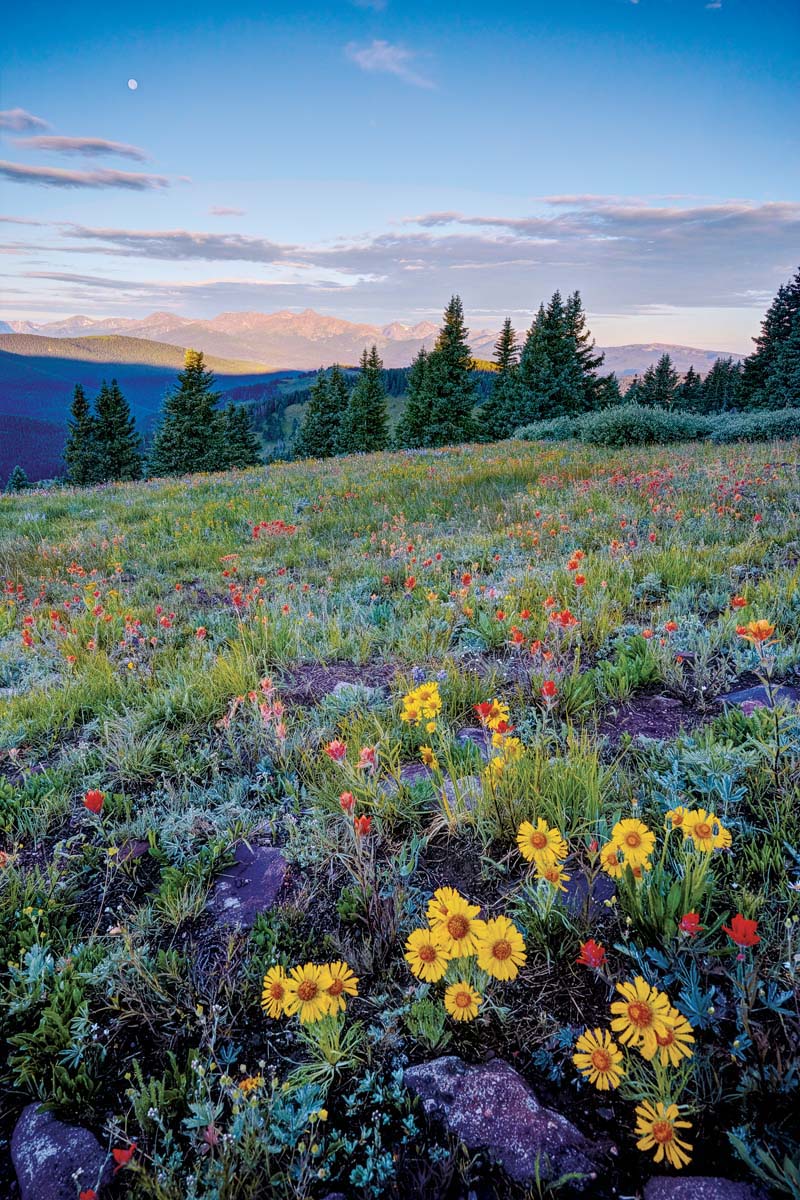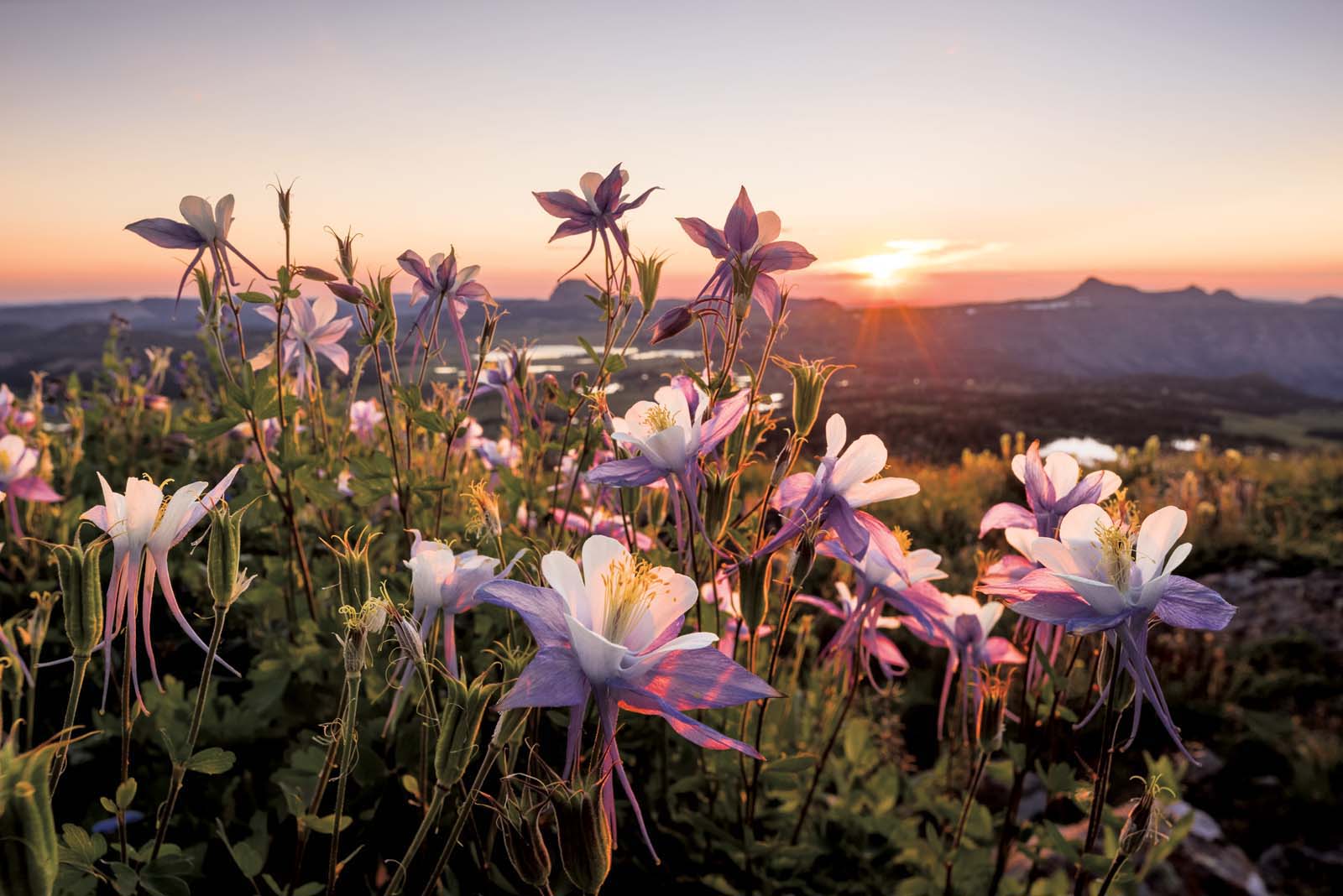The Local newsletter is your free, daily guide to life in Colorado. For locals, by locals.
Hike

On The Trail
Getting up close and personal with Colorado’s summer splendor means using your own two feet. There are, of course, plenty of classic wildflower hikes, such as the East Inlet Trail in Rocky Mountain National Park and the traverse from Aspen to Crested Butte (or vice versa) over West Maroon Pass. But with a goal of expanding your floral horizons, consider visiting these five areas of the state that bloom especially bright this month.
Crested Butte
Hikers don’t just encounter mule’s ear, lupine, and larkspur in Colorado’s Wildflower Capital—they wade through them. The proliferation of shale soil, a high number of pollinators, and decent moisture combine to produce flowers that can grow head-high. Michelle Bivens, executive director of the annual Crested Butte Wildflower Festival, recommends Dark Canyon Trail, a moderate 13.8-mile (one way) route through the Raggeds Wilderness north of Kebler Pass; the sunflower-lined, 4.3-mile (round trip) Brush Creek Trail; and Deer Creek Trail’s diverse array of flowers, which can be seen during a 6.9-mile (round trip) out-and-back hike.
Summit County

When the snow clears from the I-70 corridor, it reveals acres of Crayola-colored meadows. Shrine Mountain Trail (4.2 miles, round trip) takes flower chasers gradually up from Vail Pass, past pine forests and meadows abundant with wildflowers, to its namesake peak. Another worthy option is Dillon’s Herman Gulch Trail, which follows part of the Continental Divide Trail; the 6.6-mile (round trip) route gains about 1,600 feet as it winds past blossoming fields on its way to Herman Lake. Flatlanders—or those wanting to give their calves a break—will enjoy the columbines and easy ambling along Lower Cataract Loop Trail near Silverthorne, a mostly flat two-mile loop.
Eastern Plains
It’s become a Colorado axiom: To avoid the crowds, head east. That adage holds true for wildflower seekers. There, the colorful displays sit in startling contrast to peculiar rock formations. The popular Pawnee Buttes Trail leads hikers to the two 300-foot-tall buttes, which rise out of the verdure of Pawnee National Grassland, northeast of Greeley. The tranquil four-mile (round trip) trail is peppered with yellow-hued mountain bladderpod and various species of milk vetch. Picket Wire Canyon, outside of La Junta, provides a lengthy day of western wallflower and purple prairie vervain viewing—it’s an 11.3-mile round-trip hike—but the limited elevation gain balances out the distance.
Western Slope
The hills surrounding Grand Junction and Fruita are awash in Mother Nature’s color palette. Though the blooms typically peak in July, there are still sights to see among the region’s rugged sandstone cliffs later in the summer. You’ll need to shuttle a car ahead of time (to either the Lower Monument or Coke Ovens trailheads) so you’re able to get home after the roughly six-mile Monument Canyon Trail through-hike, which switchbacks past pink northern sweet vetch, mountain mahogany, and a whole lot of semidesert shrubs. Although we prefer to bike atop the 10,500-foot-tall Grand Mesa, the meadows and hiking trails off Highway 65 are just as enjoyable on foot.
Flat Tops Wilderness

At 230,830 acres, the Flat Tops Wilderness can seem too vast to select just one destination for finding flowers. But there’s something special about Trappers Lake, which has a shoreline loop—about 5.3 miles—that takes hikers by patches of fireweed, rosy paintbrush, and goldeneye. Flower lovers should also take the mile-long spur path up to Little Trappers Lake, where colorful fireweed has proliferated after the Big Fish fire 16 years ago. At 15.7 miles, the East Fork Trail is a solid backpacking option lined with blue columbines and sunflowers.
Around Town
There’s no need to travel far to revel in the wildflowers this summer: See them bloom at these five easily accessible venues closer to home.

At Denver Botanic Gardens Chatfield Farms (pictured) in Littleton, view more than 40 species of wildflowers, such as black-eyed Susan and golden columbine, in the Carol Gossard Native Plant Garden.
Bonus: The venue hosts Wednesday Hikes with the Gardens—weekly excursions in the foothills (sometimes, but not always, wildflower-focused) that are led by on-staff horticulturists.
At Kendrick Lake Park in Lakewood, view native and nonnative species—including sunset hyssop and Mexican hat—in the vibrant xeriscape demonstration gardens.
At Roxborough State Park (just 25 miles south of Denver), view Indian paintbrush and prairie coneflower in a 3,300-acre “transition zone,” an ecological area where flowers that typically grow far from one another are able to sprout much closer together, creating a colorful tapestry.
At Red Rock Canyon Open Space outside of Colorado Springs, view mariposa lilies, milk vetch, and golden banners from the mostly easy trails weaving through the 1,474-acre park.
At the Aurora Xeriscape Demonstration Garden, view more than 300 water-wise plants, such as Vera Jameson stonecrop and baby blue rabbitbrush.
Bonus: Free xeriscaping classes are offered at the garden every summer.
(Flower) Power Walks
Five other hikes on our summer bucket list.
1. Bob and Betty Lakes Trail
Nearest town: Winter Park Length: 12 miles, round trip
2. Williams Creek Trail
Nearest town: Pagosa Springs
Length: About six miles, round trip (a creek three miles in is your turn-around point)
3. Devil’s Thumb Trail to Jasper Lake via Devil’s Thumb Bypass
Nearest town: Nederland
Length: Nine miles, round trip
4. Three Island Lake Trail
Nearest town: Clark
Length: 7.1 miles, round trip
5. Blue Lake Trail
Nearest town: Fort Collins
Length: 10 miles, round trip
Expert Tip
“It’s not the one flower you pick—it’s the hundreds or thousands or tens of thousands of flowers that might get picked over the course of a season. You run the risk of depleting an area of a seed source. That can have a ripple effect throughout an ecosystem.” —Ben Lawhon, Leave No Trace Center for Outdoor Ethics
Bike

Rolling Through
Expect to hit the brakes often to relish the Monet-esque scenery along these singletrack routes.
Flowing Park Loop
Near: Grand Junction
Distance: 15.2 miles
Difficulty: Intermediate
What You’ll See: As you cycle along the rim and through the middle of the largest flattop mountain in the world—Grand Mesa—keep an eye out for wildflowers with some curious names: showy fleabane daisy, penstemon (also called beardtongue), common harebell, and sulphur flower.
Trail #401 Loop
Near: Crested Butte
Distance: About 14 miles
Difficulty: Intermediate
What You’ll See: This is among the world’s top-rated mountain bike trails, but we love it less for the ride itself and more for the corn lilies, aspen sunflowers, and purple tansy asters spotted here in late summer. The blooms along this path stretch high enough to reach your handlebars as you flow over smooth singletrack in the shadow of the Elk Mountains.
Ditch to Connector to West Government to Valhalla Trails
Near: Snowmass
Distance: About eight miles (round trip)
Difficulty: Expert
What You’ll See: Combining this group of trails makes for a short, grueling ride (expect to hike your bike in some spots), but you can use the narrowleaf paintbrush and elephant flowers as an excuse to stop and take photos—and catch your breath.
Field Guide
A handy manual for identifying nine of Colorado’s most beautiful late-season wildflowers.

1. Colorado Blue Columbine
(Aquilegia caerulea)
Color: Blue and white
See It: Near the start of the Handies Peak Trail in American Basin
Blooms: June through August
2. Monkshood
(Aconitum)
Color: Blueish purple
See It: Along Cub Lake Trail in Rocky Mountain National Park
Blooms: Late June to late August
3. Western Ironweed
(Vernonia baldwinii)
Color: Pinkish-purple
See It: At Rocky Mountain Arsenal—one of the few places the tall, hairy plant grows in Colorado
Blooms: August to September
4. Ute Ladies’ Tresses Orchid
(Spiranthes diluvialis)
Color: White
See It: In the protected Tallgrass Prairie East Habitat Conservation Area outside of Boulder
Blooms: July and August
5. Tulip Gentian
(Eustoma grandiflorum)
Color: Violet blue
See It: Around Denver Botanic Gardens’ Plains Garden at its York Street location
Blooms: July and August
6. Rocky Mountain Bee Plant
(Cleome serrulata)
Color: Pink
See It: Sprouting in the grasslands near Great Sand Dunes National Park and Preserve
Blooms: May through September
7. Subalpine larkspur
(Delphinium barbeyi)
Color: Purple
See It: On the 2.3-mile family-friendly Lower Cataract Loop Trail near Silverthorne
Blooms: June through August
8. Monument plant
(Frasera speciosa)
Color: White and green
See It: Towering above the grasses that surround Pass Creek Trail near the town of Silverton
Blooms: July and August
9. Dotted blazing star
(Liatris punctata)
Color: Pinkish purple
See It: While touring Picket Wire Canyon south of La Junta
Blooms: August through September
Expert Tip
“As summer melts into autumn, it becomes the season of daisies. This month, look for asters and goldenrods.”—Panayoti Kelaidis, Denver Botanic Gardens
Posy Primer
Denver Botanic Gardens wants to help you expand your wildflower expertise. Wildflowers of the Rocky Mountain Region ($27.95, Timber Press), a manual describing more than 1,200 species commonly found in the Western United States, hits bookstores later this month.
Drive

Four-Wheel Frolicking
The Alpine Loop Scenic Byway—a system of backcountry roads that traverses some of southwestern Colorado’s most epic mountain terrain—delivers intrepid Jeepers to untold caches of beautiful blooms. Although there are flowers nearly everywhere you look, we map some highlights below. —Lindsey B. Koehler
1. Yankee Boy Basin
Monument plant, paintbrush, columbine, larkspur, chiming bluebells, wild iris, dwarf sunflower, and other alpine flora nestle into this spectacular basin in the shadow of 14,150-foot Mt. Sneffels.
2. Hurricane Pass/Lake Como
From Hurricane Pass, you can look behind you
to see fields of wildflowers, or you can look down in front of you to see petal-covered slopes melt into bluer-than-blue Lake Como, the headwaters for the Uncompahgre River.
3. California Gulch
This narrow valley with a small stream often holds on to patches of snow well into summer, but the white stuff only serves as an intriguing backdrop for yellow, pink, and purple wildflowers.
4. Animas Forks
Built in the 1870s as a mining town, Animas Forks is remarkably well preserved considering its remote location. A quick walk around the property with your camera will allow you to grab images of the log structures surrounded by a rainbow of wildflowers.
5. Cinnamon Pass
Fields of yellow—with purple patches thrown in for good measure—greet you as you reach the 12,620-foot summit.

6. American Basin
Do not miss taking the short spur trail to see this striking basin, which boasts a mother lode of Colorado wildflowers. Trust us: You’ve never seen so many columbines in one place.
7. Engineer Pass
Featherleaf fleabane, elephant flowers, and a host of other posies paint the meadows and slopes surrounding this 12,800-foot pass.
On The Road Again
Three other wildflower-rich drives around the state—plus worthy stops along the way.

Million Dollar Highway
One of Colorado’s most treacherous roads—hairpin turns, no guardrails—also provides some of its most stunning wildflower panoramas. Throughout a stretch that winds roughly 23 miles between Ouray and Silverton in southwest Colorado, fields of native flowers blanket the surrounding land, particularly in U.S. Basin, on the east side of Red Mountain Pass, and then past Silverton and around 25-acre Molas Lake, just off Molas Pass.
Pit Stop: After white-knuckling it over the pass, settle your nerves with a well-deserved beer and a pizza from Avalanche Brewing Company in Silverton.
Paradise Divide
With the grassy river valley extending below it and rolling peaks rising above it, the Paradise Divide loop is a wild-bloom chaser’s nirvana. The 25-mile paved and dirt route climbs 2,500 vertical feet, following the Slate River out of Crested Butte to its headwaters and then traversing Schofield Pass to the Continental Divide and back to the Butte through Washington Gulch. Look out for curlyhead goldenweed and showy fleabane, which are common at this time of year.
Pit Stop: Irwin Brewing Company only fills growlers at its CB brewery, on Fridays and Saturdays from 3 to 6 p.m. But you can try all of its brews on draft at Public House.
Wagon Wheel Trail System
You’ll need an off-highway vehicle to explore the 600 miles of trails in northwest Colorado’s Wagon Wheel Trail System. The web of paths—which nestles into the area around Meeker and Rangely—skirts ponds, winds through aspen forests, and trundles alongside pastures ablaze in wildflowers.
Pit Stop: The White River Museum in Meeker provides an up close—and fascinating—look at the lives of early settlers and native tribes.
By Any Other Means
These four alternative modes of transportation are as wild as the Colorado flora you’ll be observing.

Travel by horse with Fantasy Ranch Horseback Adventures, Crested Butte
Because: Getting high—as in, 10,500 feet high—is the best way to see wildflowers in late August. Fantasy Ranch’s 3.5-hour Rustler’s Gulch Wilderness Ride ($165) takes guests deep into the Maroon Bells–Snowmass Wilderness, where they follow a logging road and a creek up to wide-open fields of brilliant flowers. Advance reservations are required; tours begin running on August 20 this year.
Travel by rail with Cumbres & Toltec Scenic Railroad
Because: Take in the view from the comfort of this locomotive, which chugs past the wildflower-speckled alpine meadows surrounding Cumbres Pass—the highest pass (10,015 feet) crossed by rail in the country. Or reserve a spot on the full-day Wildflower Express on August 5 ($165). Botanists will highlight flora along the route, and several impromptu stops will provide the chance to disembark and smell the flowers.
Travel by llama with Paragon Guides, Vail
Because: Who doesn’t want to have lunch with a llama—or have it carry his pack for him? Paragon’s popular, full-day Backcountry Llama Lunch ($545 base fee for two people) guides hikers along moderate-to-difficult Vail Valley trails, most of which are awash in color this month.
Travel by hot air balloon with Grand Adventure, Fraser
Because: This three-hour adventure ($275 per person) takes you across the Fraser Valley and affords views of Longs Peak and the Gore Range. As the pilot lowers to hover over the treetops, meadows and forests awash in purple (elephant flowers) and pink (wild roses) come into view.
Expert Tip
“You can just rent a Jeep and go. But here’s a little secret: The higher you go at the end of the season, the more flowers you’ll see.” —Gregg Pieper, San Juan Scenic Jeep Tours in Ouray









